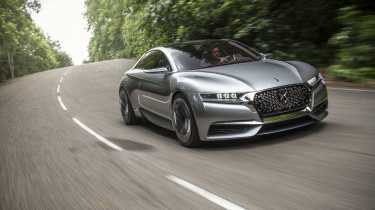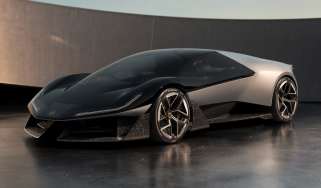DS Divine concept driven – the future of French luxury cars?
New DS brand previews its future, and evo gets a brief taster
This is not a Citroen. It might be built by Citroen, but the DS Divine concept has never worn a Citroen badge and never will; it is the physical manifestation of the French firm’s dedicated DS luxury brand, launched alongside the concept at the 2014 Paris motor show.
Nor does it preview any production car directly, Citroen or otherwise. It’s a C-segment car in size – think DS 4, or the current Citroen C4 – but unlike many modern concept cars, the DS Divine is purely a design exercise, previewing distinctive DS attributes rather than a future vehicle in its entirety.
Finally, this is not a vehicle we can dynamically assess to any degree. It’s certainly driveable – a step beyond many concept cars, which are rolled into their spots on motor show stands and rolled away again. But our drive was limited to little over 30mph and, with respect to those who built it, this is not a car we’d be comfortable driving much quicker.
The reasons for this we’ll get to shortly. First, one must stand back and appreciate the styling. There’s a lot to take in, and were the overall shape not so cohesive your eyes wouldn't know where to focus first. The basic form is simple, but the voluptuous curves are a world away from any current vehicle in the Focus/Golf/Astra class.
It's the work of designer Damien Fressard. He, along with dozens of others at Citroen's design centre, took part in an internal competition to conceptualise DS's future. Fressard won, and things moved quickly from there. He tells me the process from his first sketches to the Divine concept rotating on a Paris turntable was less than a year. Now, he's working on an actual production car for DS. He only smiles when I ask what it might be.
Divine is similar in length to other C-segment vehicles, at 4.21m. The width and the height are the real differences – at 1.98m, it’s almost 20cm wider than most others in the class. The Divine’s diminutive stature reduces the impression of girth – at 1.35m, it’s around 10cm lower than a Golf and 13cm shy of a Focus.
20-inch wheels with intricately interlaced spokes fill the arches completely, further reducing the car’s sense of bulk, while other details, such as the distinctive grille and ‘DS wings’ that carry the laser and LED headlight units, are in neat proportion with the low-slung stance.
Other noteworthy details: that grille features 3d-layered diamond forms – a detail that may make production, albeit in a mildly toned-down form. The rear lights are spectacular, dozens of individual diamond-shaped scales rising up to uncover lighting elements underneath. Don’t expect that to appear on a production vehicle any time soon.
Remarkably, Fressard tells me the lizardesque scales, where you might normally find a rear window, are also production-feasible. The view out of the rear is provided by a camera, whose image is displayed where you’d normally find a rear-view mirror – a function sure to appear in future DS road cars. The scales themselves can extend, as part of an active aerodynamics system.
Less impressive but even more production-suitable are the slim chrome blades that swoop from the bonnet through to the ultra-slim mirrors, and their counterparts at the rear that encircle the rear lights and dive down the car’s flanks.
> Click here to continue to page 2






